22.04.2017
-
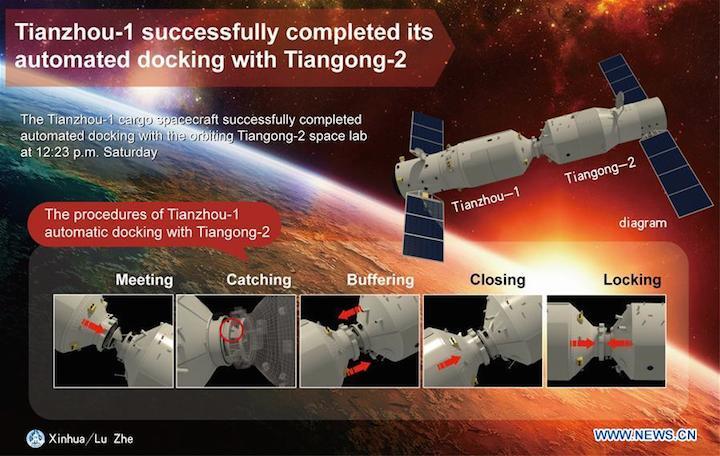
The graphics shows the procedures of Tianzhou-1 automated docking with Tiangong-2 on April 22, 2017. (Xinhua/Lu Zhe)
BEIJING, April 22 (Xinhua) -- The Tianzhou-1 cargo spacecraft successfully completed automated docking with the orbiting Tiangong-2 space lab at 12:23 p.m. Saturday, according to Beijing Aerospace Control Center.
It is the first docking between the spacecraft and space lab.
Tianzhou-1, China's first cargo spacecraft, which was launched Thursday evening from Wenchang Space Launch Center in south China's Hainan Province, began to approach Tiangong-2 automatically at 10:02 a.m. Saturday and made contact with the space lab at 12:16 p.m.
The Tianzhou-1 cargo ship and Tiangong-2 space lab will have another two dockings.
The second docking will be conducted from a different direction, which aims to test the ability of the cargo ship to dock with a future space station from different directions.
In the third docking, Tianzhou-1 will use fast-docking technology. It normally takes about two days to dock, while fast docking will take only six hours.
Refueling will also be conducted, a process with 29 steps that takes several days.
Tiangong-2, which went into space on Sept. 15, 2016, is China's first space lab "in the strict sense" and a key step in building a permanent space station.
Cargo ships play a crucial role maintaining a space station and carrying supplies and fuel into orbit.
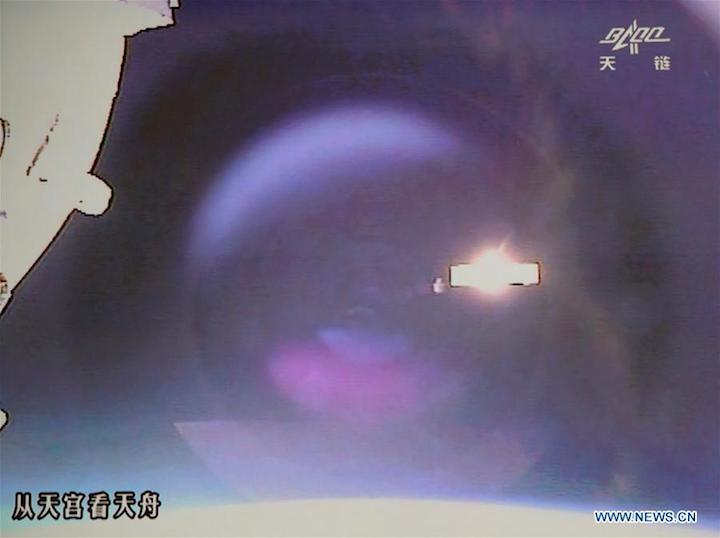
Photo taken on April 22, 2017 shows the Tianzhou-1 cargo spacecraft moving towards the orbiting Tiangong-2 space lab for the automated docking on a screen at Beijing Aerospace Control Center in Beijing, capital of China. The Tianzhou-1 cargo spacecraft, China's first cargo spacecraft, which was launched Thursday evening from Wenchang Space Launch Center in south China's Hainan Province, successfully completed automated docking with the orbiting Tiangong-2 space lab at 12:23 p.m. Saturday, according to Beijing Aerospace Control Center. It is the first docking between the spacecraft and space lab. (Xinhua/Wang Sijiang)
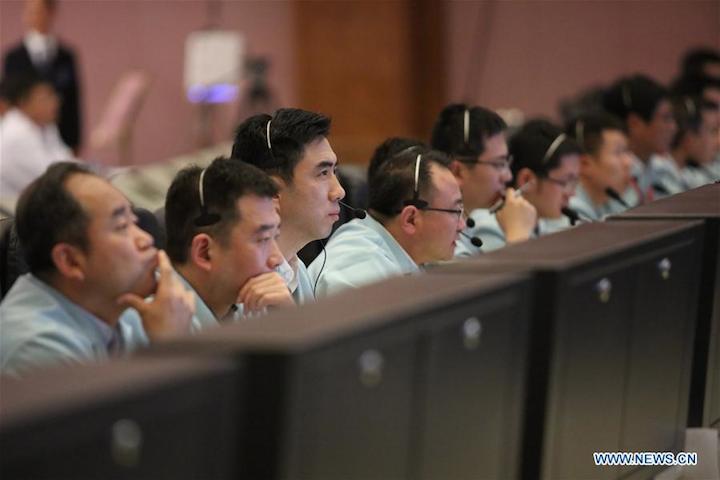
Technical personnel work at Beijing Aerospace Control Center to monitor the automated docking between Tianzhou-1 cargo spacecraft and Tiangong-2 space lab in Beijing, capital of China, April 22, 2017. The Tianzhou-1 cargo spacecraft, China's first cargo spacecraft, which was launched Thursday evening from Wenchang Space Launch Center in south China's Hainan Province, successfully completed automated docking with the orbiting Tiangong-2 space lab at 12:23 p.m. Saturday, according to Beijing Aerospace Control Center. It is the first docking between the spacecraft and space lab. (Xinhua/Yu Tao)
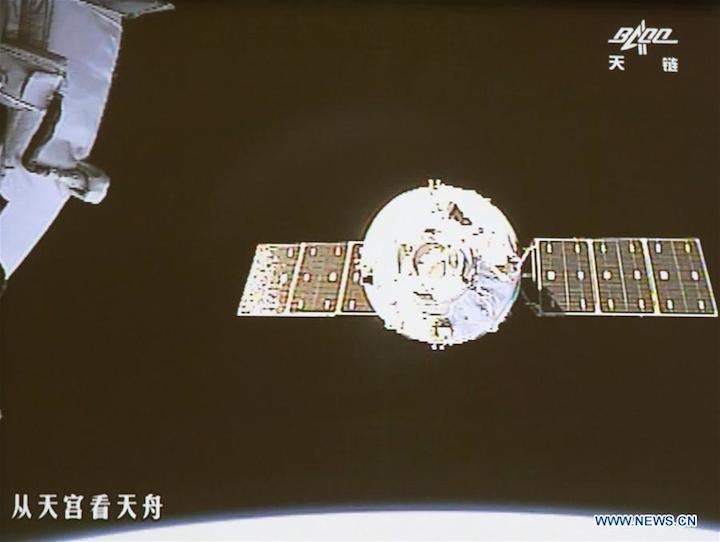
Photo taken on April 22, 2017 shows the Tianzhou-1 cargo spacecraft moving towards the orbiting Tiangong-2 space lab for the automated docking on a screen at Beijing Aerospace Control Center in Beijing, capital of China. The Tianzhou-1 cargo spacecraft, China's first cargo spacecraft, which was launched Thursday evening from Wenchang Space Launch Center in south China's Hainan Province, successfully completed automated docking with the orbiting Tiangong-2 space lab at 12:23 p.m. Saturday, according to Beijing Aerospace Control Center. It is the first docking between the spacecraft and space lab. (Xinhua/Wang Sijiang)
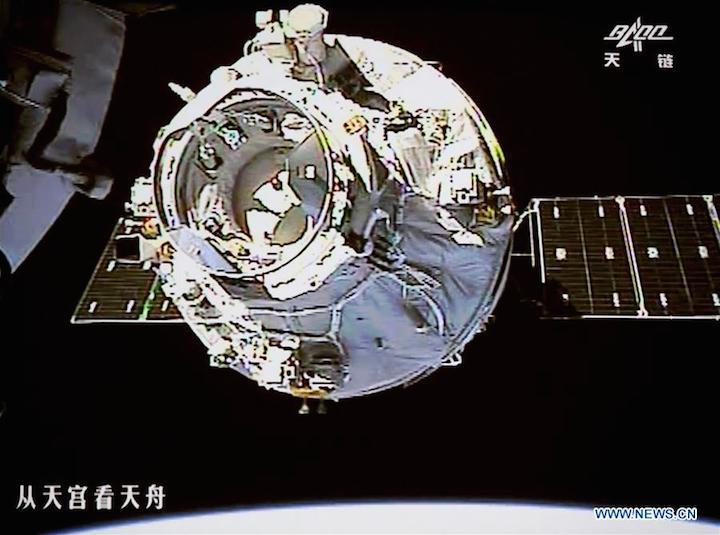
Photo taken on April 22, 2017 shows the Tianzhou-1 cargo spacecraft moving towards the orbiting Tiangong-2 space lab for the automated docking on a screen at Beijing Aerospace Control Center in Beijing, capital of China. The Tianzhou-1 cargo spacecraft, China's first cargo spacecraft, which was launched Thursday evening from Wenchang Space Launch Center in south China's Hainan Province, successfully completed automated docking with the orbiting Tiangong-2 space lab at 12:23 p.m. Saturday, according to Beijing Aerospace Control Center. It is the first docking between the spacecraft and space lab. (Xinhua/Wang Sijiang)
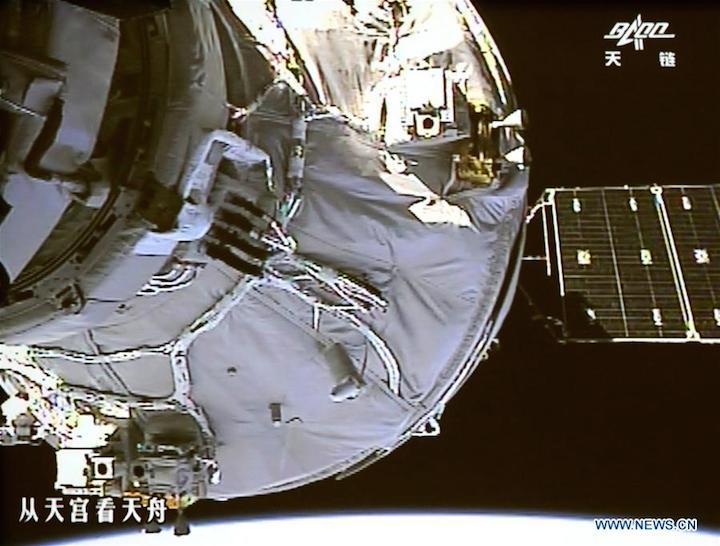
Photo taken on April 22, 2017 shows the Tianzhou-1 cargo spacecraft docking with the orbiting Tiangong-2 space lab on a screen at Beijing Aerospace Control Center in Beijing, capital of China. The Tianzhou-1 cargo spacecraft, China's first cargo spacecraft, which was launched Thursday evening from Wenchang Space Launch Center in south China's Hainan Province, successfully completed automated docking with the orbiting Tiangong-2 space lab at 12:23 p.m. Saturday, according to Beijing Aerospace Control Center. It is the first docking between the spacecraft and space lab. (Xinhua/Wang Sijiang)(wjq)
Quelle: Xinhua
---
Update: 24.04.2017
.
The plans for Tianzhou-1 following launch success
 Long March long exposure: Launch of Tianzhou-1 via Long March 7 from Wenchang on April 20, 2017. (Photo: CASC)
Long March long exposure: Launch of Tianzhou-1 via Long March 7 from Wenchang on April 20, 2017. (Photo: CASC)China on Thursday launched its first resupply spacecraft, Tianzhou-1, from Wenchang, successfully getting through the most dangerous moments of any mission.
The 13 tonne vessel, China's largest spacecraft to date, is in orbit preparing to rendezvous and dock with the Tiangong-2space lab, with which it will test the automated transfer of liquid propellant and supplies in microgravity.
These main mission objectives could begin early on Saturday, and will mark the final steps before construction begins on the large, modular Chinese Space Station (CSS) in low Earth orbit.
Docking and refuelling
While general information on what comes next has been released, Chinese space officials have not yet released precise times for the major actions.
Tianzhou-1 will dock with Tiangong-2 three times while around 390 km above the Earth, mimicking the orbit of the future CSS.
The first rendezvous and docking is now expected to take place around midday Beijing time on Saturday (04:00 UTC April 22), following a similar profile of the crewed Shenzhou-11 mission late last year.
This will start a two-month in-orbit testing of liquid propellant refuelling. It is not known if live coverage will be available, but could be facilitated, as with Shenzhou missions, by China's Tianlian data relay satellites.

Above: Tianzhou-1 refuelling Tiangong-2 in orbit (CMSA).
The refuelling procedure will consist of 29 steps and last for several days each time. "After the docking process, the propellant tube and coupling part should be perfectly matched, with a margin error less than 1 millimetre," deputy chief designer Chen Qizhong told CCTV.
The pressure differential between the fuel tanks of the two spacecraft will then see propellant automatically transferred from Tianzhou-1 to Tiangong-2. Following this, aerospace engineers will test the ability of the cargo spacecraft to control the two spacecraft.
After the initial docking, the next step will be to simulate docking with forward and backward ports of the future space station.
"This time Tianzhou-1 will separate from Tiangong-2's backward port and then fly around it to dock from the forward port to examine the docking ability," says Bai Mingsheng, chief designer of the Tianzhou-1 cargo spaceship at the China Academy of Space Technology (CAST).

Above: Shenzhou-10 docking with Tiangong-1 in June 2013.
The two spacecraft will orbit separately for three months, during which time the cargo spaceship will complete its own space science experiments.
After this period, Tianzhou-1 and Tiangong-2 will dock a third and final time to test the automatic fast-docking technology, which means to finish the docking within six hours.
"When successful, such docking method can be applied to both crewed spacecraft and cargo spaceship. A shorter docking time for crewed spaceships is of great significance as it will make astronauts more comfortable," Bai told CCTV+
Science in orbit
Like Tiangong-2, Tianzhou-1 is also carrying scientific instruments and experiments, which will run following separation after the first on-orbit refuelling test.
Since last week science experiments such as the POLAR instrument aboard Tiangong-2 ,which has been successfully detecting gamma ray bursts - some of the most powerful explosions in the universe - in order to determine their polarisation to answer fundamental questions, have been switched off.
Tianzhou-1 science payloads include a cell bioreactor to test the influence of microgravity on the development of mammalian cells and a range of embryonic stem cells. Parallel experiments will be conducted on the ground in order to provide a comparison with the results.
Experiments will include testing 3-hydroxybutyric acid, a medicine developed for astronauts but which could bring about a treatment for anyone affected by bone loss and osteoporosis.
Other payloads include a two-phase fluid instrument for spacecraft fluid management, and an electrostatic levitation accelerometer, which aims to study the unexplained vast difference in the strength of the weak force and gravity, and explore potential forces predicted by theories suggesting extra dimensions.

Above: Tianzhou-1 under construction (CAST).
With no astronauts on board, scientists and researchers on the ground will monitor the whole process of the experiments through data and image transmission.
Mission designer Liang Jianshui told state media that real-time images on the in-orbit cell cultures will be captured by camera, and [the data] on elements and devices and space probe experiments will all be transmitted to Earth.
Lessons from this interconnection between orbit and ground will be applied to the CSS, Liang says.
Silk Road cubesat
A cubesat named Silk Road-1 (丝路一号) will also be part of the Tianzhou-1 mission, to be released at an as-yet unspecified time once the main spacecraft is in its intended orbit.
The tiny, 4.5 kg remote sensing satellite was developed by the Xi'an Institute of Surveying and Mapping, with involvement from the Chinese Academy of Sciences and a number of its branches.
Silk Road-1 is designed to be a pathfinder for a constellation of around 30 satellites operating across a variety of wavelengths.

Above: A rendering of Silk Road-1 being released from Tianzhou-1 (Framegrab/CCTV).
End of mission
Unlike the doomed Tiangong-1 space lab, Tianzhou-1 will be deliberately de-orbited and burn up in the Earth's atmosphere at the end of its mission, much like the cargo craft used by Russia, Japan and the United States, with the exception of SpaceX's partly reusable Dragon 2.
For future missions involving the CSS, Tianzhou craft will be used to remove waste from the space station. The CSS is being designed to be in orbit for at least 10 years, with the core module expected to launch in late 2018 or early 2019.
Tiangong-1 launched in late 2011 and was visited by the uncrewed Shenzhou-8 and crewed Shenzhou-9 in June 2012 and Shenzhou-10 in June 2013.
The 8-tonne craft is expected to make an uncontrolled reentryinto the Earth's atmosphere sometime late this year.
Quelle: gbtimes
+++
Tianzhou-1 begins orbital refuelling test with Tiangong-2
The refuelling test in microgravity is the primary objective for the Tianzhou-1 mission, which follows successful rendezvous and docking with Tiangong-2 early on Saturday.
Refuelling tests began at 07:26 Beijing time on Sunday (23:26 UTC Saturday), monitored from the Beijing Aerospace Control Centre (BACC). The refuelling process involves 29 steps and will take five days to complete.
To allow refuelling to take place, the propellant tube and coupling components needed to be perfectly matched after docking, with a margin error of less than 1 millimetre, according to Tianzhou-1 deputy chief designer Chen Qizhong.

Above: A rendering of Tianzhou-1 refuelling Tiangong-2 (CMSA).
The mission involving the Tianzhou and Tiangong spacecraft was designed to prove on-orbit resupply and refuelling technologies and techniques necessary for safe, long-term operation of the Chinese Space Station, which will be permanently crewed by at least three astronauts.
"After refuelling is completed, the residual propellant needs to be drained off. In order to identify security issues during the draining process, it needs to go through a number of tests and verification," Bai Mingsheng, chief designer of Tianzhou-1, told CCTV+.
Quelle: gbtimes
---
Update: 28.04.2017
.
China's cargo spacecraft completes in-orbit refueling
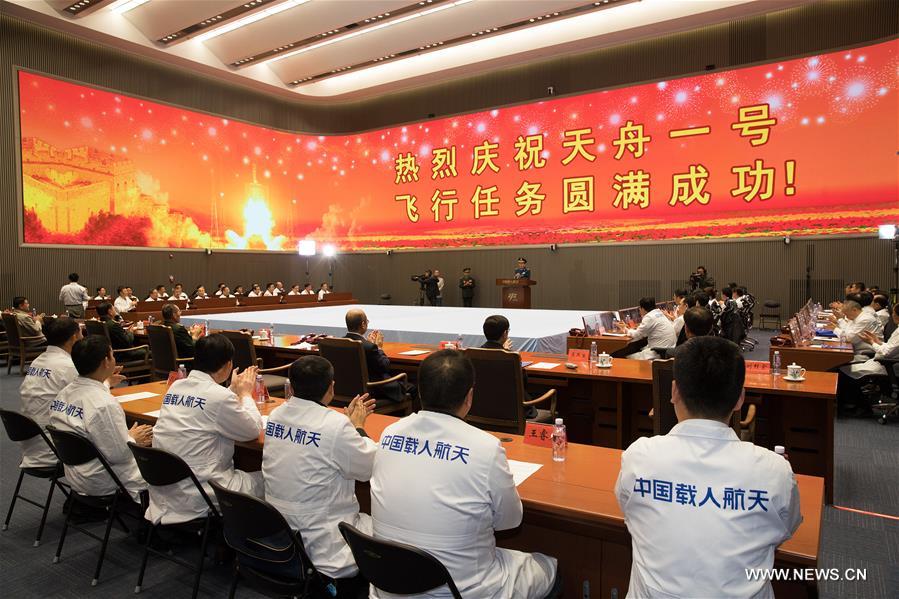
Working staff celebrate at the control center in Beijing, capital of China, April 27, 2017. China's Tianzhou-1 cargo spacecraft and Tiangong-2 space lab completed their first in-orbit refueling at 7:07 p.m. Thursday, another success of the Tianzhou-1 mission. (Xinhua/Ju Zhenhua)
BEIJING, April 27 (Xinhua) -- China's Tianzhou-1 cargo spacecraft and Tiangong-2 space lab completed their first in-orbit refueling at 7:07 p.m. Thursday, another success of the Tianzhou-1 mission.
Mastering the technique of refueling in space will help the country to build a permanent space station.
China is the third country, besides Russia and the United States, to master refueling in space.
The in-orbit refueling, under control of technicians on Earth, takes about five days, as the propellant is transmitted from the cargo spacecraft to the space lab.
A second refueling in space will be conducted after the cargo ship's second docking with the space lab in June, which aims to test the ability of the cargo ship to dock with the space station from different directions.
In the last docking, Tianzhou-1 will use fast-docking technology. Previously, it took China about two days to dock, while fast docking will take about six hours, according to Bai Mingsheng, chief designer of the cargo ship.
Tianzhou-1, China's first cargo spacecraft, was launched on April 20 from Wenchang Space Launch Center in south China's Hainan Province.
It completed its first automated docking with the orbiting Tiangong-2 space lab on April 22.
The Central Military Commission (CMC) sent a congratulatory letter to the staff of China's manned space program on the success of the Tianzhou-1 mission, speaking highly of the contributions they have made to the country's space industry.
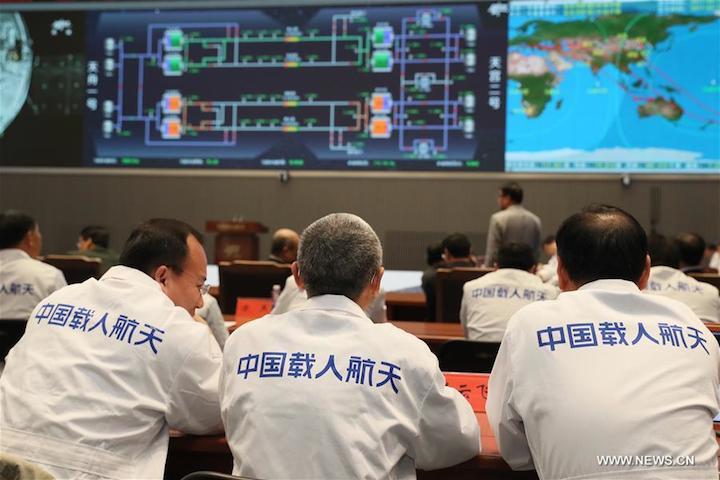
"It means a lot in realizing our unremitting space dream, and will inspire us to break new ground," the CMC said in the letter.
In 1992, the central authority approved a three-step manned space program, with the final step marking the ability to operate a permanent manned space station, which is planned to be put into orbit around 2022.
As the International Space Station is set to retire in 2024, the Chinese space station will offer a promising alternative, and China will be the only country with a permanent space station.
Quelle: Xinhua

